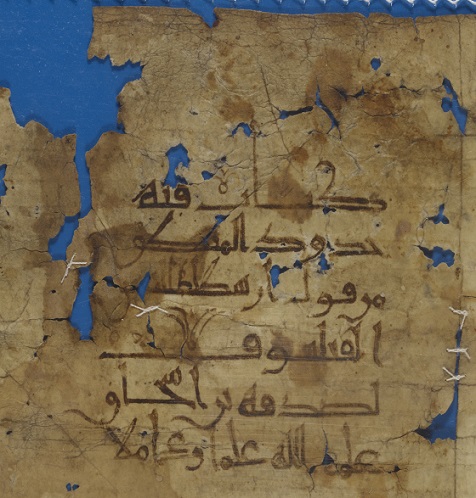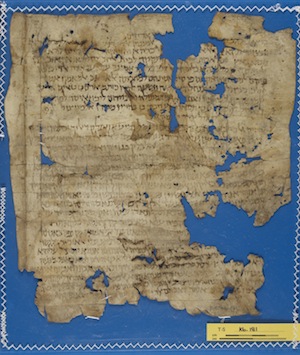A Judaeo-Arabic version of Ibn Bahrīz’s treatise on logic, T-S K6.181
Gabriele Ferrario, Ronny Vollandt
The three folders that bear the classmark T-S K6 contain altogether about 200 fragments, mostly the colophons of books. Although a large number have already been studied and published, there are, however, some very interesting items that have not hitherto been noted. Fragment T-S K6.181 is one of them. It preserves the Arabic colophon and beginning of a previously unknown Judaeo-Arabic version of the treatise Kitāb ḥudūd al-manṭiq (‘The Definitions of Logic’) by ʿAbdīshūʿ Ibn Bahrīz.
The fragment consists of one parchment folio with a stub, exhibiting ruling and pricking marks. It is in relatively poor condition and shows many signs of the ravages of time. The verso in particular is badly rubbed, to the extent that entire passages are illegible. Fortunately, however, the Arabic title on recto is preserved in its entirety. It is written in a calligraphic Abbasid book hand and reads kitāb fīhi ḥudūd al-manṭiq min qawl Arisṭuṭalis al-faylasūf li-Ṣadaqa Ibn Isḥāq, ‘The book regarding the definitions of logic based on Aristotle the philosopher, belonging to Ṣadaqa Ibn Isḥāq’.

Title page of the Kitāb ḥudūd al-manṭiq in an Abbasid bookhand, T-S K6.181,r.
The 28 lines of the verso, containing the beginning of the Judaeo-Arabic text, are written in a formal Hebrew square script. The Judaeo-Arabic orthography shows some hallmarks of Early Phonetic Judaeo-Arabic Script (EPJS), which dropped out of use in the tenth century. All in all, the evidence points to an early date for this copy, probably the tenth century.
The East-Syriac Metropolitan ʿAbdīshūʿ Ibn Bahrīz, author of Kitāb ḥudūd al-manṭiq, was active at the turn of the eighth and ninth centuries. A well-versed polymath, with interests ranging from religion to philosophy and from maths to medicine and law, he is found in ʿAbdīshūʿ bar Brīkhā’s (d. 1318) rhymed canon of East-Syriac authors. In addition, his life and works are mentioned by three Arabic authors: al-Jāḥiẓ (d. 868) lists him among the translators of Aristotle in his Kitāb al-ḥayawān, ‘The Book of Animals’, and Kitāb al-bayān wa’l-tabyīn, ‘The Book of Eloquence and Exposition’. Al-Nadīm (d. 995) refers to him three times in his Kitāb al-Fihrist: first, Ibn Bahrīz is mentioned in the section of Christian authors as the Metropolitan of Ḥarrān and later of Mosul and Ḥazza. He is further reported to have written epistles and books on the Christian faith and to have translated many books on logic and philosophy under the patronage of the Abbasid caliph al-Maʾmūn. Finally, al-Nadīm mentions the East-Syriac scholar among the epitomisers of ‘The Categories’ and ‘On Interpretation’ in his list of Aristotle’s books on logic. The last medieval source in regard to Ibn Bahrīz is found in Ibn Abī Uṣaybīʿa, who makes reference to him as a friend and translator for the East-Syriac physician Gabriel Ibn Bakhtīshūʿ. An Arabic translation from the Syriac of Nicomachus of Gerasa’s Introduction to Arithmetic, commissioned by the Abbasid military officer Ṭāhir ibn al-Ḥusayn, should be added to the list of Ibn Bahrīz’s writings.
Only two of Ibn Bahrīz’s original works are extant today: a juridical treatise on marriages, heritages and judgments in Syriac and Kitāb Ḥudūd al-Manṭiq. The latter was edited by Dāneshpazhūh in 1978 on the base of two twelfth-century Arabic manuscripts preserved in Istanbul (Rāġib Pāšā, 1464/4) and Damascus (Ẓāhiriyya 4871/40). Kitāb ḥudūd al-manṭiq is a short treatise composed on behest of al-Maʾmūn, in which the author presents a summary and simplification of Aristotelian books on logic and their commentaries. The intention of the treatise is didactic and this may be the reason why in the Damascus manuscript the text takes the shape of a series of tables.
The treatise, as preserved on the verso of fragment T-S K6.181, opens with a brief summary of the contents of the book (lines 1–3), including the transcription, formulation, abstraction, figuration and definition of the elements of Aristotelian logic. It is followed by a dedication to the caliph al-Maʾmūn (lines 4–6) and another explanation of the subject of the treatise (lines 7–10). The name of the author, Ibn Bahrīz muṭrān al-Mawṣul, is only mentioned in line 9. What follows is a lengthy introduction, in which Ibn Bahrīz dwells on the blessings of God, on His unity and the wisdom displayed in His creation: evident and apparent things act as a guide in the discovery of the hidden things, just like a bridge connecting the two banks of a river or like the stairs of a bridge for a man wanting to step up them (lines 28–29).
The discovery of this version of the Kitāb ḥudūd al-manṭiq is notable for at least two reasons: first, the manuscript in which it is preserved predates all the known extant complete Arabic witnesses of the book; second, this is the only known Judaeo-Arabic version of this treatise on logic.
As this brief note will hopefully have shown, the Genizah still has many surprises in store for scholars of Arabic literature!
The Judaeo-Arabic text of the Kitāb ḥudūd al-manṭiq, T-S K6.181,v.
Bibliography
M. T. Dāneshpazhūh (ed.), Ḥudūd al-Mantiq by Ibn Bihriz (Tehran, 1978).
G. Freudenthal & T. Lévy, ‘De Gérase à Bagdad: Ibn Bahrīz, Al-Kindī, et leur recension arabe de l’Introduction Arithmétique de Nicomaque, d’après la version hebraïque de Qalonymos ben Qalonymos d’Arles’, in R. Morelon & A. Hasnawi (eds), Da Zénon d’Élée à Poincaré. Recueil d’études en hommage à Roshdi Rashed (Louvain–Paris, 2004), pp. 479–544.
G. Graf, Geschichte des christlichen arabischen Literatur (5 vols; Vatican City, 1944–1953), vol. II, pp. 119–120.
T. Langermann, ‘Arabic Writings in Hebrew Manuscripts: a Preliminary Relisting’, Arabic Sciences and Philosophy 6 (1996), pp. 137–160.
J. Ragep & E. S. Kennedy, ‘A Description of Ẓāhiriyya (Damascus) Ms 4871: A Philosophical and Scientific Collection’, Journal for the History of Arabic Science 5 (1981), pp. 85–108.
M. Steinschneider, Die arabischen Übersetzungen aus dem Griechischen (Leipzig, 1893), pp. 227–228.
—, Die hebraeischen Übersetzungen des Mittelalters und die Juden als Dolmetscher (Berlin, 1893), pp. 517–518.
G. Troupeau, ‘Abdīšūʿ Ibn Bahrīz et son livre sur les definitions de la logique’, in D. Jacquart (ed.), Les voies de la science greque. Études sur la transmission des texts de l’Antiquité au dix-neuvième siècle (Genève, 1997), pp. 135–145.
Cite this article
(2010). A Judaeo-Arabic version of Ibn Bahrīz’s treatise on logic, T-S K6.181. [Genizah Research Unit, Fragment of the Month, September 2010]. https://doi.org/10.17863/CAM.55279
If you enjoyed this Fragment of the Month, you can find others here.
Contact us: genizah@lib.cam.ac.uk
The zoomable images are produced using Cloud Zoom, a jQueryimage zoom plugin:
Cloud Zoom, Copyright (c) 2010, R Cecco, www.professorcloud.com
Licensed under the MIT License

